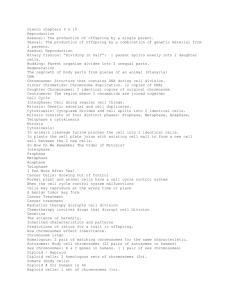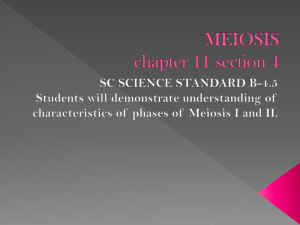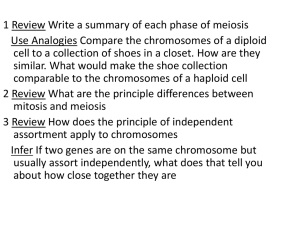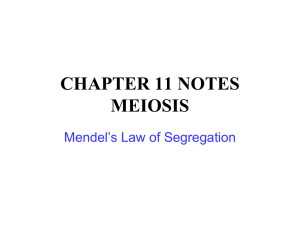File
advertisement
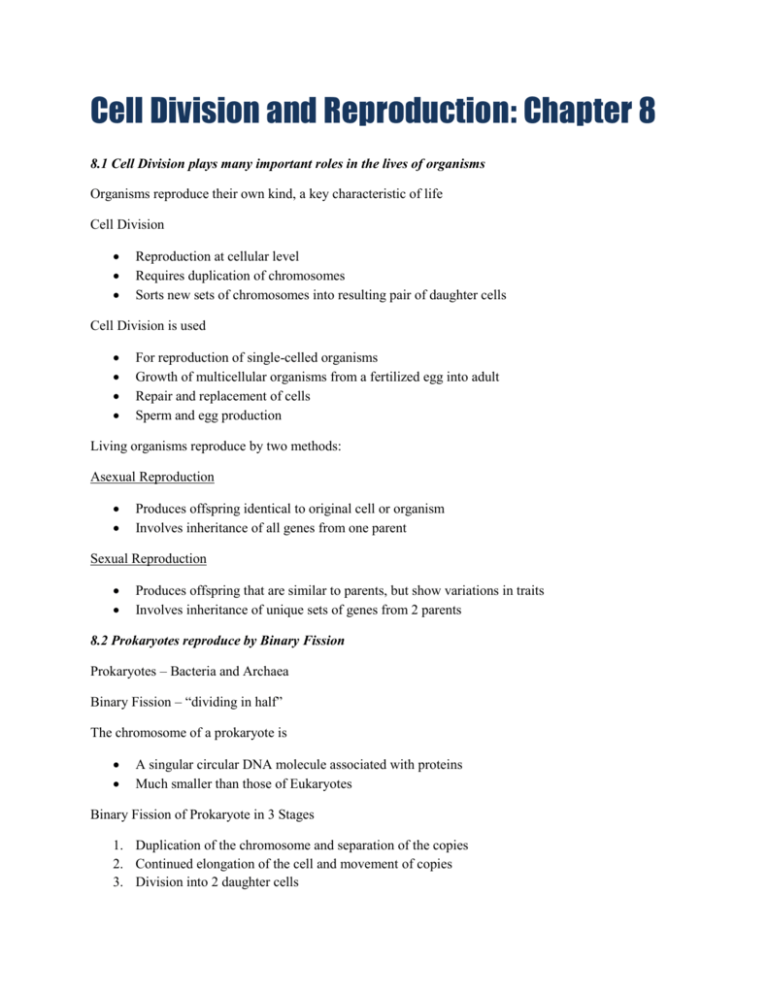
Cell Division and Reproduction: Chapter 8 8.1 Cell Division plays many important roles in the lives of organisms Organisms reproduce their own kind, a key characteristic of life Cell Division Reproduction at cellular level Requires duplication of chromosomes Sorts new sets of chromosomes into resulting pair of daughter cells Cell Division is used For reproduction of single-celled organisms Growth of multicellular organisms from a fertilized egg into adult Repair and replacement of cells Sperm and egg production Living organisms reproduce by two methods: Asexual Reproduction Produces offspring identical to original cell or organism Involves inheritance of all genes from one parent Sexual Reproduction Produces offspring that are similar to parents, but show variations in traits Involves inheritance of unique sets of genes from 2 parents 8.2 Prokaryotes reproduce by Binary Fission Prokaryotes – Bacteria and Archaea Binary Fission – “dividing in half” The chromosome of a prokaryote is A singular circular DNA molecule associated with proteins Much smaller than those of Eukaryotes Binary Fission of Prokaryote in 3 Stages 1. Duplication of the chromosome and separation of the copies 2. Continued elongation of the cell and movement of copies 3. Division into 2 daughter cells THE EUKARYOTIC CELL AND MITOSIS Review of “Eukaryotic” Cell Larger and more complex than Prokaryotic Have more genes Store most of genes in multiple chromosomes within nucleus 8.3 The large, complex chromosomes of Eukaryotes duplicate with each cell division Eukaryotic chromosomes are composed of Chromatin consisting of: One long DNA molecule Proteins that help maintain the chromosome structure and control the activity of its genes To prepare for cell division, the Chromatin becomes Highly compact Visible with a microscope Before a Eukaryotic cell begins to divide, it duplicates all of its chromosomes, resulting in 2 copies called Sister Chromatids Joined together by narrow “waist” called the Centromere When a cell divides, the sister chromatids Separate from each other, now called Chromosomes, and Sort into separate daughter cells 8.4 The cell cycle multiplies cells Cell Cycle – ordered sequence of events that extends From time a cell is 1st formed from a dividing parent cell Until its own division Cell Cycle consists of 2 stages: 1. Interphase: Duplication of Cell Contents G1 = growth, increase in cytoplasm S = duplication of Chromosomes G2 = growth, preparation for division 2. Mitotic Phase: Division Mitosis = division of the nucleus Cytokinesis = division of Cytoplasm 8.5 Cell Division is a continuum of Dynamic changes Mitosis progresses through a series of stages: Prophase Prometaphase Metaphase Anaphase Telophase Cytokinesis often overlaps Telophase A Mitotic Spindle is Required to divide the chromosomes Composed of microtubules Produced by Centrosomes, structures in the Cytoplasm that Organize microtubule arrangement Contain a pair of centrioles in animal cells Interphase Cytoplasmic contents double 2 Centrosomes form Chromosomes duplicate in the nucleus during the S phase Nucleoli (sites of ribosome assembly) are visible Prophase In the cytoplasm microtubules begin to emerge from Centrosomes, forming the spindle In the Nucleus Chromosomes coil and become compact Nucleoli disappear Prometaphase Spindle Microtubules reach chromosomes, where they Attach at Kinetochores on the Centromeres of sister Cromatids Move chromosomes to center of cell through associated protein “motors” Other microtubules meet those from the opposite poles The nuclear envelope disappears Metaphase Mitotic spindle is fully formed Chromosomes align at the cell equator Anaphase Sister Chromatids separate at the centromeres Daughter chromosomes are moved to opposite poles of the cell as Motor proteins move the chromosomes along the spindle microtubules Telophase Cell continues to elongate Nuclear envelope forms around Chromosomes at each ople. Establishing daughter nuclei Chromatin uncoils and nucleoli reappear The spindle disappear During Cytokinesis, the cytoplasm is divided into separate cells; The process of Cytokinesis differs in animal and plant cells 8.6 Cytokinesis differs for plant and animal cells In animal cells, Cytokinesis occurs as 1. A Cleavage Furrow forms from a contracting ring of microfialaments, interacting with myosin 2. the Cleavage Furrow deepens to separate contents into 2 cells In plant cells, Cytokinesis occurs as 1. A Cell Plate forms in the middle, from vesicles containing cell wall material 2. The cell plate grows outward to reach the edges, dividing the contents into 2 cells 3. Each Cell now possesses a plasma membrane and cell wall 8.7 Anchorage, Cell Density, and Chemical Growth factors affect Cell Division The cells within an organism’s body divide and develop at different rates Cell Division is controlled by The presence of essential nutrients Growth Factors, proteins that stimulate division Density-Dependent Inhibition, in which crowded cells stop dividing and Anchorage Dependence, the need for cells to be in contact with a solid surface to divide 8.8 Growth Factors signal the Cell Cycle control system The cell cycle control system is a cycling set of molecules in the cell that Trigger and Coordinate key events in the cell cycle Checkpoints in the cell cycle can Stop an event or Signal an event to proceed There are 3 major checkpoints in cell cycle 1. G1 Checkpoint: Allow entry into S phase or Causes cell to leave the cycle, entering a nondividing G0 phase 2. G2 Checkpoint 3. M Checkpoint Meiosis and Crossing Over 8.11 Chromosomes are matched in Homologous Pairs In Humans, Somatic Cells have - 23 pairs of homologous chromosomes and One member of each pair from each parent The human sex chromosomes X and Y differ in size and genetic composition Homologous Chromosomes are matched in - Length - Centromere position - Gene locations A Locus (plural: Loci) is the position of a gene Different versions of a gene may be found at the same locus on maternal and paternal chromosomes 8.12 Gametes have a single set of Chromosomes An organism’s life cycle is the sequence of stages leading - From the adults of one generation To the adults of the next Humans and many animals and plants are Diploid, with body cells that have: - 2 sets of chromosomes One from each parent Meiosis is a process that converts diploid nuclei to haploid nuclei - Diploid Cells have two homologous sets of Chromosomes Haploid Cells have one set of chromosomes Meiosis occurs in the sex organs, producing Gametes – sperm and eggs Fertilization – union of sperm and egg The Zygote has a diploid chromosome number, one set from each parent All sexual life cycles include an alteration between - A Diploid state and A Haploid state Producing haploid gametes prevents the chromosome number from doubling in every generation Meiosis Meiosis is a type of cell division that produces haploid gametes in diploid organisms 2 haploid gametes combine in fertilization to restore the diploid state in the zygote Meiosis and mitosis are preceded by the duplication of chromosomes, however - Meiosis is followed by 2 consecutive cell divisions Mitosis is followed by only 1 cell division Because in meiosis, one duplication of chromosomes is followed by 2 divisions, each of the 4 daughter cells produced has a haploid set of chromosomes Meiosis I – Prophase I - Events occurring in the nucleus Chromosomes coil and become compact Homologous chromosomes come together as pairs by synapsis Each pair, with 4 Chromatids, is called a tetrad Non-sister chromatids exchange genetic material by crossing over Meiosis I – Metaphase I - Tetrads align at the cell equator Meiosis I – Anaphase I - Homologous pairs separate and move toward opposite poles of cell Meiosis I – Telophase I - Duplicated chromosomes have reached the poles A nuclear envelope re-forms around chromosomes in some species Each nucleus has the haploid number of chromosomes 8.13 Meiosis reduces the Chromosome number from Diploid to Haploid Meiosis II follows Meiosis I without chromosome duplication Each of the 2 Haploid products enters meiosis II Meiosis II – Prophase II - Chromosomes coil and become compact (if uncoiled after Telophase I) Nuclear envelope, if re-formed, breaks up again Meiosis II – Metaphase II - Duplicated chromosomes align at the cell equator Meiosis II – Anaphase II - Sister chromatids separate and Chromosomes move toward opposite poles 8.15 Independent Orientation of Chromosomes in Meiosis and Random Fertilization lead to varied offspring Genetic Variation in gametes results from - Independent orientation at Metaphase I and Random Fertilization Crossing over Independent orientation at Metaphase I - Each pair of Chromosomes independently aligns at cell equator There is an equal probability of the maternal or paternal chromosome facing a given pole The # of combinations for chromosomes packaged into gametes is 2n where n = haploid # of chromosomes Random Fertilization – the combination of each unique sperm with each unique egg increases genetic variability 8.16 Homologous Chromosomes may carry different versions of genes Separation of homologous chromosomes during meiosis can lead to genetic differences btwn gametes - Homologous chromosomes may have different versions of a gene at same locus One version was inherited from maternal parent and the other came from the paternal parent Since homologues move to opposite poles during Anaphase I gametes will receive either maternal or paternal version of gene 8.17 Crossing Over further increases genetic variability Genetic recombination is production of new combinations of genes due to crossing over Crossing over – an exchange of corresponding segments btwn separate (nonsister) Chromatids on homologous chromosomes - Non-sister chromatids join at a Chiasma the site of attachement and crossing over Corresponding amounts of genetic material are exchanged btwn maternal and paternal (nonsister) chromatids Alterations of Chromosome # and Structure 8.19 CONNECTION – Extra copy of chromosome 21 causes Down Syndrome Trisomy 21 - involves inheritance of 3 copies of chromosome 21 Is most common human chromosome abnormality 8.20 Accidents during meiosis can alter chromosome # Nondisjunction – failure of chromosomes or chromatids to separate normally during meiosis. This can happen during - Meiosis I, if both members of a homologous pair go to one pole or Meiosis II if both sister chromatids go to one pole Fertilization after nondisjunction yields zygotes with altered numbers of chromosomes 8.22 New species can arise from errors in cell division - Errors in mitosis or meiosis may produce polyploid species with more than 2 chromosome sets Formation of polyploid species is most often found in plants and less frequently found in animals 8.23 CONNECTION: Alterations of Chromosome Structure can cause Birth Defects and Cancer Chromosome breakage can lead to rearrangements that can produce - Genetic disorders If changes occur in the Somatic cells, Cancer These rearrangements include - Deletion: loss of chromosome segment Duplication: the repeat of a chromosome segment Inversion: the reversal of a chromosome segment Translocation: the attachment of a segment to a non-homologous chromosome that can be reciprocal



